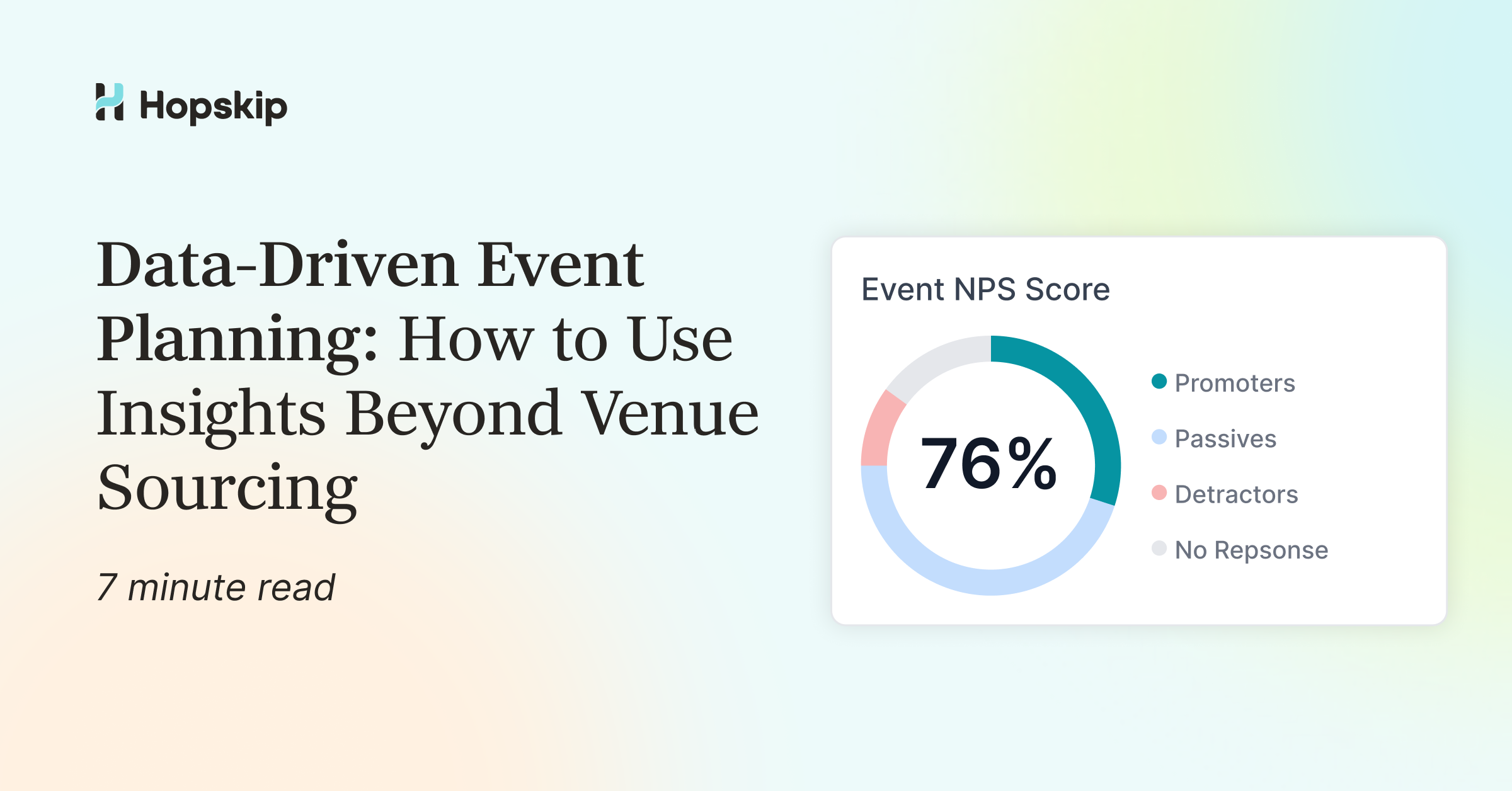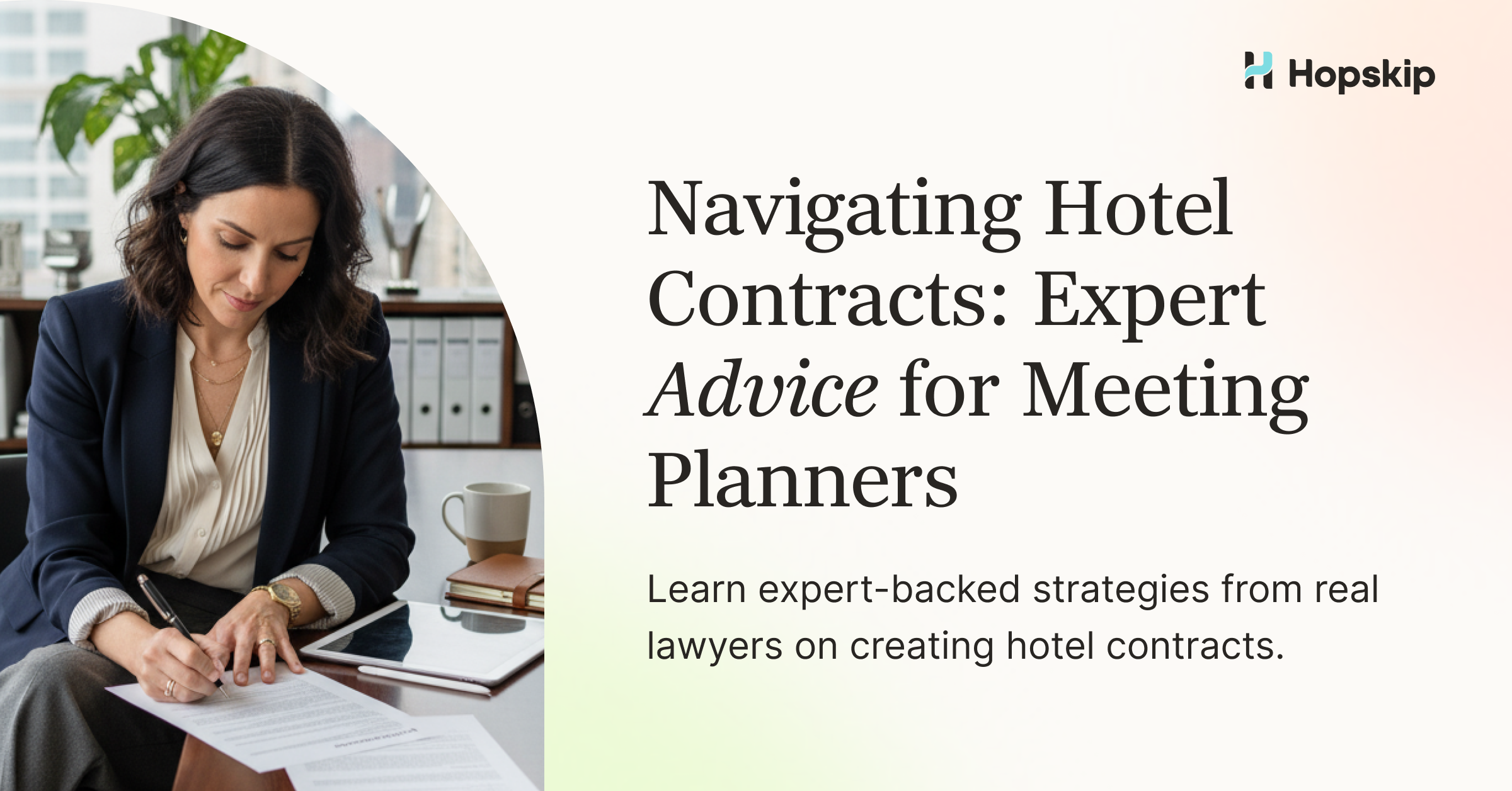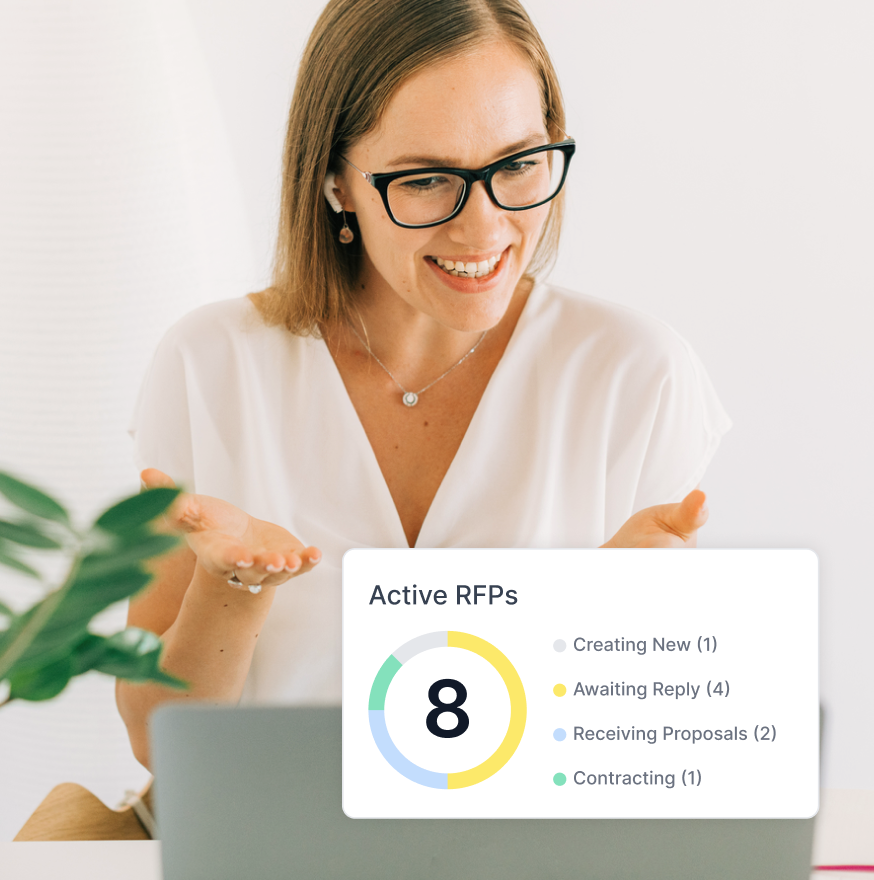Contracts
What is an Event RFP? Step-by-Step Guide for Planners
Kate Robertson
Oct 20, 2025
If you’re new to event planning (or just tired of the endless back-and-forth with hotels), you’ve probably heard someone mention “sending out an RFP.” But what exactly is an event RFP, and why does it feel like everyone in the meetings and events industry treats it like the secret handshake you should already know?
Don’t worry. We’re breaking it all down in plain English (with zero jargon-induced headaches). By the end of this guide, you’ll know exactly what an RFP is, how to write one that gets results, and why mastering this process might just be your superpower as an event planner.
What Does RFP Stand For?
Let’s start with the basics. RFP stands for Request for Proposal. In the event planning world, an RFP is a formal document you send to hotels, venues, or vendors asking them to submit proposals for your upcoming event. Think of it as your wish list meets a job application—you’re telling venues exactly what you need, and they’re pitching why they’re the perfect match.
An event RFP typically includes details like:
- Event dates (or flexible date ranges)
- Number of attendees
- Room block requirements (how many guest rooms you need)
- Meeting space needs
- Food and beverage requirements
- Budget expectations
- Any special requests or must-haves
The goal? To gather competitive proposals from multiple venues so you can compare apples to apples and make the smartest decision for your event.
Why Event Planners Use RFPs
You might be wondering: “Can’t I just call a hotel and ask for pricing?” Sure, you could. But here’s why sending an RFP is the smarter move:
It saves you time. Instead of having 12 separate phone calls with 12 different sales managers, you send one detailed RFP and let the proposals come to you.
It levels the playing field. When every venue receives the same information, you get proposals that are actually comparable. No more guessing if Hotel A’s quote includes AV while Hotel B’s doesn’t.
It creates a paper trail. Everything’s in writing, which means no “wait, I thought you said the breakfast was included?” moments three months down the line.
It gives you negotiating power. When venues know you’re shopping around (and they will), they’re more motivated to put their best foot forward with competitive pricing and perks.
It looks professional. A well-crafted RFP signals that you know what you’re doing and that you’re serious about your event.
Types of Events That Need RFPs
RFPs aren’t just for massive corporate conferences. Here are the types of events where sending an RFP makes sense:
- Corporate meetings and conferences (the classic use case for RFPs)
- Trade shows and exhibitions
- Product launches
- Sales kickoffs and training sessions
- Company retreats and team-building events
- Board meetings and executive offsites
- Large weddings (especially destination weddings with room blocks)
- Conventions and annual meetings
- Incentive trips and reward programs
- Fundraising galas and nonprofit events
If your event needs overnight accommodations, meeting rooms, or involves 20+ people, an RFP is probably your best friend.
How to Write an Event RFP: Step-by-Step Process
Ready to write your first RFP or level up your current process? Here’s your step-by-step event RFP template:
Step 1: Start With Basic Event Information
First impressions matter—even in RFPs! Think of this opening section as your elevator pitch to potential venues. You want to give hotels enough context to immediately understand your event and get excited about hosting it. This is where you set the stage for everything that follows, so don’t skimp on the details:
- Your event name and organization (be specific: “TechCorp Annual Sales Kickoff” beats “meeting”)
- Event dates (be specific or provide a 2-3 date range if you have flexibility)
- Preferred location, city, or geographic area (downtown? near airport? specific neighborhood?)
- Total number of attendees expected (give your realistic projection, not your dream number)
- Event type and purpose (conference, training, retreat, celebration, board meeting)
- Your organization’s industry or sector
- Whether this is a first-time event or an annual gathering
- Any relevant context about your group (Fortune 500 company, nonprofit, association, etc.)
Pro tip: If your dates are flexible, definitely say so! Hotels might offer significantly better rates on shoulder days (Sunday-Thursday) or during their need periods. Something like “preferred dates are June 12-14, but we’re flexible within a two-week window” gives sales managers room to work their magic on pricing.
Step 2: Outline Your Room Block Needs
Here’s where you get into the nitty-gritty of sleeping arrangements. Let’s face it, well-rested attendees are happy attendees (and they’ll actually show up to that 8am breakfast session). Hotels are laser-focused on room nights since that’s their bread and butter, so being crystal clear here helps them craft accurate proposals. The more specific you are, the better proposals you’ll receive:
- Number of rooms needed per night (break it down night by night if it varies)
- Check-in and check-out dates (including early arrivals and late departures)
- Room types needed (single kings, double queens, accessible rooms)
- Number of suites required (junior suites, one-bedroom, hospitality suites)
- VIP or speaker room requirements and any special amenities they need
- Your anticipated pick-up rate (what percentage of your block you realistically expect to fill; typically 80-90% is standard)
- Complimentary room ratio expectations (usually 1 comp per 50 rooms, but varies)
- Cut-off date for your room block (when unreserved rooms are released back to the hotel)
- Whether you need a group booking code or individual reservation links
Pro tip: Be honest about your room pick-up projections. Hotels have seen it all, and they’ll sniff out inflated numbers instantly. If you typically hit 75% of your block, say so—it builds trust and helps hotels structure attrition clauses that work for both of you. Also, consider asking about run-of-house (ROH) pricing, where the hotel guarantees a rate but assigns room types based on availability at check-in.
Step 3: Detail Your Meeting Space Requirements
Now we’re getting to the heart of what makes an event, well, an event: the actual meeting spaces! This section requires some serious thought because one size definitely doesn’t fit all when it comes to meeting rooms. A ballroom that’s perfect for 300 people in theater style becomes awkwardly cavernous for 50 people in rounds. Paint a vivid picture of your spatial needs so hotels can match you with the right rooms:
- Number and type of meeting rooms needed (general session, breakouts, exhibit hall, registration area)
- Room setup styles for each space (theater, classroom, banquet rounds, hollow square, U-shape, boardroom)
- Capacity requirements for each setup and session
- Your detailed daily schedule and timeline (minute-by-minute is helpful)
- Session timing and any quick-flip room changes needed
- Breakout room needs (how many concurrent sessions?)
- Exhibit or trade show space requirements with booth dimensions
- Registration desk or welcome desk space and timing
- Pre-function or networking space outside meeting rooms
- Green room or speaker ready room needs
- Storage space for materials, swag, or AV equipment
- 24-hour hold on rooms or flexibility for hotels to use spaces during downtime
Pro tip: Create a simple spreadsheet or visual schedule showing which rooms you need when. Something like “Day 1: 8am-5pm General Session (200 theater), 10:30am-12pm Breakouts A-D (50 each classroom)” helps hotels visualize your flow and identify potential space conflicts before they become problems. Also, always ask about room rental fees—some hotels waive them when you meet F&B minimums, while others charge regardless. Knowing this upfront helps you compare proposals accurately.
Step 4: Specify Food and Beverage Needs
Here’s where you get to play matchmaker between your attendees and their appetites. Trust us, happy, well-fed attendees are engaged attendees. Be thorough about your F&B requirements:
- Number of meals and breaks per day (including timing)
- Breakfast style (continental, buffet, plated service)
- Lunch and dinner specifications (plated vs. buffet, courses, service style)
- Coffee breaks and refreshment needs (because no one makes good decisions without caffeine)
- Hosted bars, cash bars, or drink tickets
- Dietary restrictions to accommodate (vegan, gluten-free, kosher, halal, allergies)
- Any special culinary requests or themed dinners
- Welcome receptions or networking events
- Snacks for breakout sessions
Pro tip: Don’t just say “breakfast for 100.” Specify when you need breakfast (7-8:30am?) and what style works best for your group. A sit-down plated breakfast takes longer than a grab-and-go continental spread, and hotels need to know which you’re expecting.
Step 5: List Your AV and Technology Requirements
In today’s hybrid and high-tech event world, your AV setup can literally make or break your event, so this section deserves some serious attention. Nobody wants to be that planner scrambling to find a working microphone five minutes before the keynote. Here’s what to include:
- Projectors and screens (size matters here; specify what you need for your room capacity)
- Microphones (wireless handhelds, podium mics, lavalier/lapel mics for panelists)
- Sound systems and speakers appropriate for room size
- Lighting needs (basic, theatrical, mood lighting for evening events)
- Confidence monitors or teleprompters for speakers
- WiFi bandwidth requirements (especially critical for live polling, streaming, or if attendees need to work)
- Live streaming or hybrid event capabilities
- Recording equipment or services
- Technical support staffing (will you need an on-site AV tech all day?)
- Power strips and charging stations for attendees
- Digital signage or display screens for wayfinding
Pro tip: AV costs can balloon faster than you can say “wireless lavalier microphone,” so separate your absolute must-haves from your nice-to-haves. Also, ask if the venue allows outside AV vendors—some hotels require you to use their in-house services (which can get pricey), while others are more flexible.
Step 6: Include Budget and Payment Terms
Let’s talk money: everyone’s favorite part (said no planner ever). You don’t need to show all your cards upfront, but giving hotels a realistic budget range helps them craft proposals that actually work for you instead of wasting everyone’s time. Nobody wins when a hotel sends you a $500/night rate when your budget is $200. Here’s what to address:
- Your approximate budget per room per night (or a range)
- Food and beverage budget expectations or per-person targets
- Total event budget if you’re comfortable sharing
- When you need proposals returned (give at least 7-10 business days)
- Payment terms and deposit requirements you’re expecting
- Cancellation policy expectations and attrition clauses
- Preferred contract terms or any deal-breakers
- Tax exemption status if applicable (nonprofits, take note)
Pro tip: If you’re not sure what to budget, do a little homework first. Check similar hotels in your target city to get a baseline. And remember: being vague about budget often results in proposals all over the map. A simple “We’re targeting $225-275 per night” gives hotels a clear playing field and shows you’ve done your research.
Step 7: Add Special Requests and Must-Haves
This is your moment to think beyond the basics and get creative with what’ll make your event truly special (or just functional; we don’t judge). Every event has its unique quirks, and this section is where you spell out anything that doesn’t fit neatly into the standard boxes. Think of it as your event’s personality showing through:
- Sustainability requirements (LEED-certified venues, locally-sourced food, minimal single-use plastics)
- Accessibility needs (ADA compliance, wheelchair access, hearing assistance devices, service animal accommodations)
- Parking requirements (complimentary, valet, number of spaces, EV charging stations)
- Transportation needs (airport shuttle service, local transportation for off-site events)
- On-site registration desk space and support
- Branding and signage opportunities (can you hang banners? digital displays?)
- Early load-in or late load-out needs for exhibits or decor
- Recreational activities or team-building options (spa access, golf, outdoor activities)
- VIP amenities (welcome gifts, room upgrades, special turndown service)
- Privacy requirements (buyouts, exclusive use of spaces)
- On-site storage for materials or swag
Pro tip: Flag your absolute non-negotiables clearly (maybe with asterisks or a “Must-Have” designation). If your attendees genuinely need accessible rooms and you require a venue with step-free access throughout, make that crystal clear upfront. It saves everyone time if a hotel can’t meet your dealbreakers.
Step 8: Set Clear Deadlines and Next Steps
You’re in the home stretch! Finish strong by giving hotels a clear roadmap of what happens next, because nothing kills momentum like ambiguity. Think of this as your event RFP’s closing argument. Hotels need to know not just when you need their proposal, but what your entire decision timeline looks like:
- Proposal submission deadline (be specific: “Friday, March 15th by 5pm EST” beats “mid-March”)
- Your preferred contact method and primary point of contact (email? phone? carrier pigeon?)
- How you’d like to receive proposals (PDF via email? through an RFP platform?)
- Your internal review and decision timeline (we’ll decide by X date)
- Site visit availability and preferred dates if you’re planning property tours
- When you expect to make a final decision
- Contract signing timeline and expectations
- Any other key milestones in your planning process
Pro tip: Give yourself buffer time in your timeline. If you tell hotels you’ll decide by March 30th, make sure you’ve actually got time to review proposals, potentially schedule site visits, negotiate, and get internal approvals. Under-promise and over-deliver on your timeline—hotels will appreciate the professionalism, and you won’t be that planner sending “sorry, we need another week” emails.
Event RFP Best Practices
Want your RFP to stand out and get the best responses? Keep these tips in mind:
Be realistic about your numbers. Hotels can spot inflated attendance numbers from a mile away. Be honest about your expected turnout.
Give adequate response time. Two weeks is standard, but during peak season, give hotels a bit more breathing room.
Not everything is a dealbreaker. Be clear about what’s negotiable and what’s not.
Use an RFP management platform. Tools like Hopskip streamline the entire process, letting you send RFPs to multiple hotels simultaneously and track responses in one place. No more lost emails or forgotten follow-ups.
Personalize when possible. Even though you’re sending to multiple venues, a quick note about why you’re interested in their property goes a long way.
Follow up. If you haven’t heard back within a week of your deadline, a friendly nudge is totally appropriate.
What Happens After You Send Your RFP?
Once your RFPs are out in the world, here’s what typically happens:
- Hotels review your request and decide if they can accommodate your needs
- You receive proposals (usually within 1-2 weeks) with pricing, availability, and terms
- You compare proposals side by side, looking at total cost, value, and fit
- You narrow down your top choices and schedule site visits to see the properties in person
- You negotiate terms and work toward a contract with your chosen venue
- You sign the contract and officially book your event space
Common Event RFP Mistakes to Avoid
Even seasoned planners sometimes trip up on RFPs. Here’s what to watch out for:
Being too vague. “We need some meeting space” doesn’t give hotels enough to work with. Specifics equal better proposals.
Forgetting to proofread. Typos and wrong dates create confusion and can delay the process.
Sending to too many venues. Quality over quantity. Target 5-8 hotels that truly fit your needs rather than blasting 30.
Not doing your homework. Make sure the venues you’re RFPing actually match your event profile. A 500-person conference doesn’t belong at a 75-room boutique hotel.
Ignoring response times. If you need proposals in 3 days, you’re probably going to get rushed (and potentially incomplete) responses.
Making Event RFPs Easier With Technology
Let’s be real: sending RFPs manually via email is time-consuming and prone to chaos. That’s where RFP management software comes in clutch.
Platforms like Hopskip let you:
- Create and send RFPs to multiple hotels at once
- Track which venues have opened and responded to your RFP
- Compare proposals side by side in a clean dashboard
- Communicate with hotel sales teams in one centralized place
- Store all your event details and documents in one spot
- Get faster responses (seriously, hotels prioritize RFPs from platforms they trust)
It’s like having an assistant who never sleeps and never loses an email thread.
The Bottom Line on Event RFPs
An event RFP might seem like just another piece of planning paperwork, but it’s actually one of your most powerful tools. A well-crafted RFP saves you time, gets you better deals, and sets your event up for success from day one.
The key is being thorough, realistic, and clear about what you need. The more information you provide upfront, the better proposals you’ll receive (and the easier your decision becomes).
So next time someone asks “Have you sent out the RFP yet?” you can confidently say yes, knowing you’ve nailed the process. Now go forth and request those proposals like the pro planner you are.
Ready to streamline your RFP process? Check out Hopskip’s venue sourcing platform and see how much easier event planning can be when you’ve got the right tools in your corner. Start for free.




